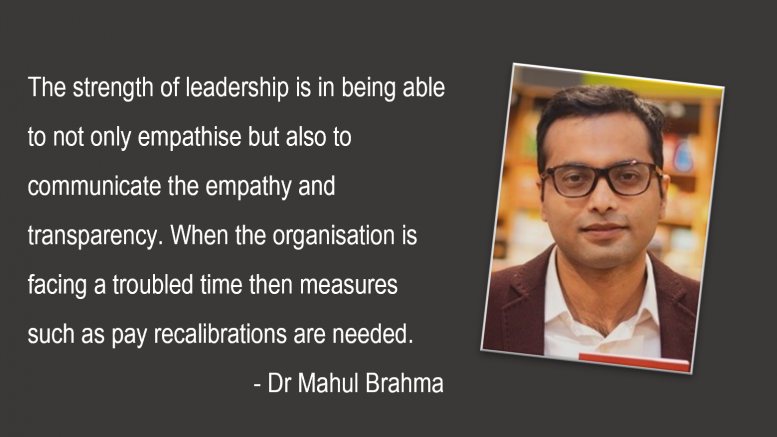In the day and age of WITFM or rather What’s In It For Me why at all is empathy needed by a leader? In the age of selfies and self-promotion why should one care of someone else’s feeling? Seems utterly illogical…well only on the surface. Let’s dig deeper to understand.
Let us first clarify the difference between sympathy and empathy as this difference means a world in the realm of media communication, especially leadership communication. According to Oxford Advanced Learner’s Dictionary the difference is between feeling sorry for someone and the ability to understand and person’s feeling or experience. The nuance is critical because in the latter case there is action involved, especially through communication.
As an MD or CEO, one needs to take action, every moment. Taking tough calls are an integral part of job description. And a leader needs to do it very effectively, making sure that every such action is either preceded or followed by transparent empathetic communication showing that the leader understands and cares. For leaders, it needs a little recalibration of their minds, just feeling bad or sympathetic is not good enough.
For example, if an organisation has to take a business decision of rightsizing workforce to keep it viable then empathy in leadership communication becomes critical. The tone and tenor of the communication to the stakeholders is the cornerstone of a leadership communication.
It is not only enough to be empathetic, it is important to communicate as well. So every stakeholder needs to be communicated the rationale behind any tough decision as above. Some leaders choose to be silent during such period of transition, this is bad leadership. Every key decision needs to be communicated by the leader and the tenor should have empathy. The leader should not come across as somebody who does not care or lacks a heart. The demonstration of strength and resilience of a leader lies in being empathetic and kind under duress. Communication thus needs to clearly define the premise that includes how the leader is with the stakeholders and not someone who is cold and refuses to understand the distress scenario.
It is a weakness of a leader to distance himself/herself from the stakeholders, especially internal. “Us versus them” is an inefficient form of leadership that has been discontinued in modern management globally. Therefore, leadership communication needs to transparently show, it is always “us”.
The strength of leadership is in being able to not only empathise but also communicate the empathy and transparency. When the organisation is facing a troubled time then measures such as pay recalibrations are needed. This is a time when the leader should be able to strategise a series of communication over a period of time as below:
- A business decision needs to be taken that salary recalibration is inevitable for viability.
- All internal stakeholders need to be sensitised as to how the business needs drastic steps to survive.
- CEO or MD needs to lead the way by communicating how he or she as well as the top management is taking a pay restricting. This communication is needed for the buy-in of the internal stakeholders. So not only the recalibration but also the communication is essential. And then, if needed, the restructuring may need to percolate to middle and junior management. This phase-wise top-down salary-restructuring will ensure a smooth impact of the step.
- Empathy of the leader will ensure that internal stakeholder remain loyal even during challenging times.
- And gaining the trust of the stakeholders during the toughest of times is a true sign of strength of a leader.
- Communicate, communicate, communicate to all stakeholders – internal as well as external, including Board.
Every leader should remember that it is only “us” in any organisation and leadership communication is all about empathy and transparency.
The views and opinions published here belong to the author and do not necessarily reflect the views and opinions of the publisher.



Be the first to comment on "Power of empathy in leadership communication"